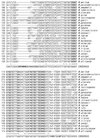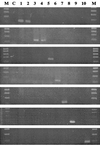Detection and identification of mycobacteria by amplification of the internal transcribed spacer regions with genus- and species-specific PCR primers
- PMID: 11060072
- PMCID: PMC87545
- DOI: 10.1128/JCM.38.11.4080-4085.2000
Detection and identification of mycobacteria by amplification of the internal transcribed spacer regions with genus- and species-specific PCR primers
Erratum in
- J Clin Microbiol 2001 Feb;39(2):828
Abstract
We evaluated the usefulness of PCR assays that target the internal transcribed spacer (ITS) region for identifying mycobacteria at the species level. The conservative and species-specific ITS sequences of 33 species of mycobacteria were analyzed in a multialignment analysis. One pair of panmycobacterial primers and seven pairs of mycobacterial species-specific primers were designed. All PCRs were performed under the same conditions. The specificities of the primers were tested with type strains of 20 mycobacterial species from the American Type Culture Collection; 205 clinical isolates of mycobacteria, including 118 Mycobacterium tuberculosis isolates and 87 isolates of nontuberculous mycobacteria from 10 species; and 76 clinical isolates of 28 nonmycobacterial pathogenic bacterial species. PCR with the panmycobacterial primers amplified fragments of approximately 270 to 400 bp in all mycobacteria. PCR with the M. tuberculosis complex-specific primers amplified an approximately 120-bp fragment only for the M. tuberculosis complex. Multiplex PCR with the panmycobacterial primers and the M. tuberculosis complex-specific primers amplified two fragments that were specific for all mycobacteria and the M. tuberculosis complex, respectively. PCR with M. avium complex-, M. fortuitum-, M. chelonae-, M. gordonae-, M. scrofulaceum-, and M. szulgai-specific primers amplified specific fragments only for the respective target organisms. These novel primers can be used to detect and identify mycobacteria simultaneously under the same PCR conditions. Furthermore, this protocol facilitates early and accurate diagnosis of mycobacteriosis.
Figures




Similar articles
-
Novel diagnostic algorithm for identification of mycobacteria using genus-specific amplification of the 16S-23S rRNA gene spacer and restriction endonucleases.J Clin Microbiol. 2000 Mar;38(3):1094-104. doi: 10.1128/JCM.38.3.1094-1104.2000. J Clin Microbiol. 2000. PMID: 10699003 Free PMC article.
-
Evaluation of the LiPA MYCOBACTERIA assay for identification of mycobacterial species from BACTEC 12B bottles.J Clin Microbiol. 2000 May;38(5):1915-9. doi: 10.1128/JCM.38.5.1915-1919.2000. J Clin Microbiol. 2000. PMID: 10790121 Free PMC article.
-
Multiplex PCR assay for simultaneous detection and differentiation of Mycobacterium tuberculosis, Mycobacterium avium complexes and other Mycobacterial species directly from clinical specimens.J Appl Microbiol. 2009 Aug;107(2):425-35. doi: 10.1111/j.1365-2672.2009.04218.x. Epub 2009 Mar 16. J Appl Microbiol. 2009. PMID: 19302308
-
Agents of newly recognized or infrequently encountered mycobacterial diseases.Clin Microbiol Rev. 1992 Jan;5(1):1-25. doi: 10.1128/CMR.5.1.1. Clin Microbiol Rev. 1992. PMID: 1735092 Free PMC article. Review.
-
The mycobacteria: an introduction to nomenclature and pathogenesis.Rev Sci Tech. 2001 Apr;20(1):21-54. doi: 10.20506/rst.20.1.1265. Rev Sci Tech. 2001. PMID: 11288513 Review.
Cited by
-
The Clinical Features and Bacteriological Characterizations of Bone and Joint Tuberculosis in China.Sci Rep. 2015 Jun 8;5:11084. doi: 10.1038/srep11084. Sci Rep. 2015. PMID: 26053666 Free PMC article.
-
Rapid identification of mycobacteria from smear-positive sputum samples by nested PCR-restriction fragment length polymorphism analysis.J Clin Microbiol. 2008 Nov;46(11):3591-4. doi: 10.1128/JCM.00856-08. Epub 2008 Sep 3. J Clin Microbiol. 2008. PMID: 18768657 Free PMC article.
-
Specificity and performance of PCR detection assays for microbial pathogens.Mol Biotechnol. 2004 Jan;26(1):61-80. doi: 10.1385/MB:26:1:61. Mol Biotechnol. 2004. PMID: 14734824 Review.
-
Computational approach involving use of the internal transcribed spacer 1 region for identification of Mycobacterium species.J Clin Microbiol. 2005 Aug;43(8):3811-7. doi: 10.1128/JCM.43.8.3811-3817.2005. J Clin Microbiol. 2005. PMID: 16081916 Free PMC article.
-
A prospective study of non-tuberculous mycobacterial disease among tuberculosis suspects at a tertiary care centre in north India.Indian J Med Res. 2019 Nov;150(5):458-467. doi: 10.4103/ijmr.IJMR_194_19. Indian J Med Res. 2019. PMID: 31939389 Free PMC article.
References
-
- American Thoracic Society. Diagnosis and treatment of disease caused by nontuberculous mycobacteria. This official statement of the American Thoracic Society was approved by the Board of Directors, March 1997. Medical Section of the American Lung Association. Am. J. Respir. Crit. Care Med. 156:S1–25. - PubMed
-
- Aranaz A, Liebana E, Mateos A, Dominguez L, Vidal D, Domingo M, Gonzolez O, Rodriguez-Ferri E F, Bunschoten A E, van Embden J D, Cousins D. Spacer oligonucleotide typing of Mycobacterium bovis strains from cattle and other animals: a tool for studying epidemiology of tuberculosis. J Clin Microbiol. 1996;34:2734–2740. - PMC - PubMed
-
- Chang C L, Son H C, Kim S H, Kim C M, Chung B S, Park S K, Park H K, Jang H J, Song S D. Proceedings of XX World Congress of Pathology and Laboratory Medicine. Bologna, Italy: Litosei-Rostignano-Bologna; 1999. Detection of mycobacteria by amplifying the internal transcribed spacer regions with novel genus-specific primers; pp. 19–23.
-
- Connors T D, Burn T C, VanRaay T, Germino G G, Klinger K W, Landes G M. Evaluation of DNA sequencing ambiguities using tetramethylammonium chloride hybridization conditions. Biotechniques. 1997;22:1088–1090. - PubMed
Publication types
MeSH terms
Substances
Associated data
- Actions
- Actions
LinkOut - more resources
Full Text Sources
Other Literature Sources
Medical
Molecular Biology Databases

